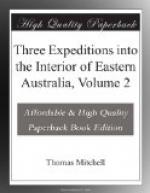(Footnote. Isaiah 24:17 Fear, and the pit, and the snare are upon thee.] “These images are taken from the different methods of hunting and taking wild beasts which were anciently in use. The snare or toils were a series of nets enclosing, at first, a great space of ground in which the wild beasts were known to be, and drawn in by degrees into a narrower compass till they were at last closely shut up and entangled in them.” Harmer. This is precisely the method adopted by the Australian natives at present for the same or similar purposes.)
REMARKABLE CHARACTER OF THE LAKES.
On laying down my survey of the country which we had lately passed over I found that the lakes were nearly all circular or oval, and that a very regularly curved ridge, as before stated, bounded the eastern shore of all of them. The number of lakes or hollows of this character already seen by us to the south-west of the Murray amounted to eleven. In three of them the water was salt, and the greater number had no communication with the river; but between it and the others there was a narrow creek or gully, but accessible only to the highest floods. The northern margin of one of the salt lakes consisted of a bank of white sand on which grew thickly a kind of pine, different from the trees around. The channels between the river and the lakes seemed neither to belong to the original arrangement of watercourses, nor to ana-branches of the rivers; for they frequently extended upwards in directions opposed to that of the river’s course. The fact being established that some of these lakes have no obvious connection with the river, it becomes probable that they are the remains of what the surface was before the fluviatile process began to carry off its waters. I had no difficulty in referring to an early system of this kind other lakes which we had seen elsewhere, the anomalous peculiarities of which were equally remarkable. Among these were Cudjallagong and others adjacent; Waljeers; the two smaller on the Murrumbidgee named Weromba; also Lake Benanee and Prooa its neighbour; in all which the peculiarities accorded with what I had observed in those on the left bank of the Murray.
MR. STAPYLTON’S EXCURSION IN SEARCH OF THE MAIN STREAM.
June 27.
The morning was clear and Mr. Stapylton set out with a party of six men to trace, if possible, the branch on which we were encamped into the main stream. At ten the weather became hazy; at noon the sky was overcast; and at two P.M. a steady rain set in which continued until six P.M. when the barometer began to rise and, the moon soon after shining out, the sky became once more serene. A hill apparently covered with good grass was within sight of our present camp but inaccessible from it because a reach of deep and still water intervened. This day I sent Burnett with Piper to the hill, and they brought me some of the soil which I found consisted of loose red sand.




